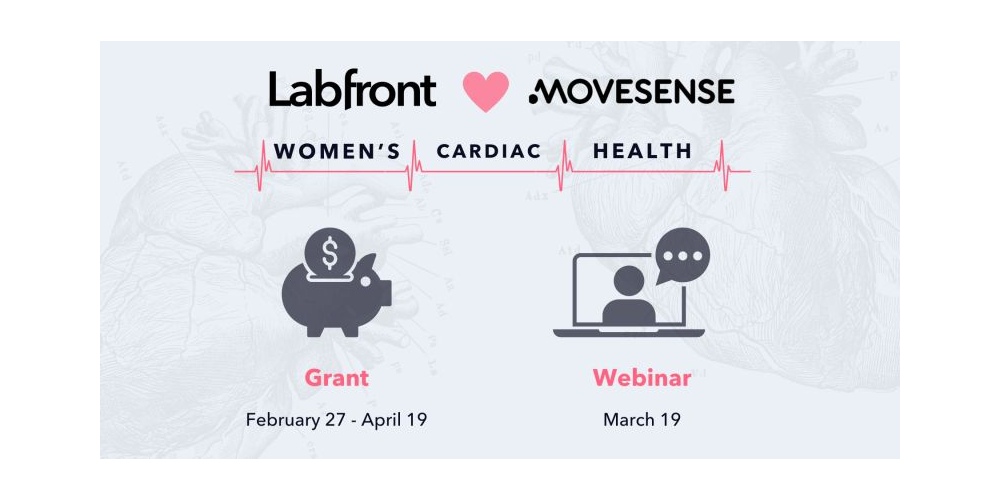Women’s Heart Disease: Gender-specific Considerations

Cardiovascular disease, historically misconceived as a predominantly male-centric pathology, is the leading cause of mortality in women globally. Together with our partner Labfront, Movesense wants to increase awareness of the important issue of women’s heart disease and encourage researchers to develop new gender-inclusive healthcare practices.
We’ll organize a webinar on March 19 11:00 AM EDT / 16:00 CET with the topic “Unlocking cardiac and movement data, and much more with wearables in Health Research”. Welcome to learn how Movesense and Labfront solutions help in health research! Read more and register for the webinar.
Movesense and Labfront are also offering the Women’s Cardiac Health Research Grant to address gender disparities in heart disease treatment and diagnosis.
In this article we review the distinctive nuances of women’s heart disease that are essential in understanding and managing women’s cardiac health.
Atypical Symptoms
One of the most significant reasons why women’s heart disease receives less attention than it should is the subtle symptoms of the disease. The typical symptoms of heart disease, such as classic chest pain, are actually mainly typical for men. Women often exhibit subtler signs, such as shortness of breath, nausea, fatigue, and pain in the jaw, neck, or back. This characteristic variability in symptoms poses a diagnostic challenge, as healthcare providers and even women themselves may not immediately recognize these indicators as potential heart issues.
Hormonal Influences
Hormonal fluctuations, particularly during menopause, introduce another layer of complexity to women’s cardiac health. Estrogen, traditionally considered a cardiovascular protector, declines during menopause. This is potentially increasing the risk of heart disease in women. As women age, they face a unique set of challenges that demand specialized attention in managing their cardiovascular well-being.
Sociomedical Factors
Gender-based inequities in healthcare contribute to the underrepresentation of women in cardiovascular research and clinical trials. This sustains the misconception of heart disease as a predominantly male phenomenon and hinders the development of gender-specific prevention and treatment strategies. Bridging this gender gap is essential for advancing women’s heart health and ensuring that scientific research, cardiovascular guidelines, and healthcare practices are equally applicable and effective across genders.
Prevention and Intervention
Prevention is a cornerstone of managing heart disease in women. Lifestyle modifications, such as adopting a heart-healthy diet, engaging in regular physical activity, maintaining a healthy weight, and managing stress, are a significant part of preventive actions.
Healthcare providers also play a crucial role in addressing women’s heart disease. They are responsible for the necessary routine screenings, blood pressure monitoring, cholesterol assessments, and individual risk factor evaluations that are essential components of comprehensive care.
Recognizing the unique challenges faced by women, healthcare providers can improve care outcomes by tailoring interventions that meet the specific needs of female patients, incorporating a holistic approach that addresses both traditional and gender-specific risk factors.
Furthermore, education and awareness campaigns at the societal level are essential tools in empowering women to recognize the importance of proactive measures and to dispel myths surrounding cardiovascular health.
Wearable ECG monitors
Wearable ECG monitors such as Movesense MD offer a promising avenue for advancing cardiovascular care of both women and men. These devices provide continuous, non-invasive monitoring of the heart’s electrical activity, allowing for early detection, personalized interventions, and enhanced management of cardiovascular conditions. With the subtle symptoms that too often go unnoticed, continuous monitoring is especially important for women.
Wearable ECG technology also contributes to the collection of real-world data, fostering research into gender-specific aspects of cardiovascular health.
Movesense and Labfront advance women’s heart health research by providing researchers with world-class tools for large-scale data collection, management, and analysis. Movesense sensors are ideal for unobtrusive collection of 1-lead ECG, heart rate variability, and activity data in test subject’s daily life. Read more about using Movesense sensors in research.
Labfront is an all-in-one research platform for real-world data capture. It enables fluent data collection, easier adherence management, faster analysis, and offers native support for using Movesense sensors as a data collecting device.
In addition to research projects, the Movesense MD sensor, certified as a Class IIa medical device (MDR), is suitable for clinical care and remote patient monitoring. It can be quicky integrated into existing data systems and applications, and its customizable firmware and open API’s allow companies and developers to tailor it to specific healthcare needs.
Views: 78
